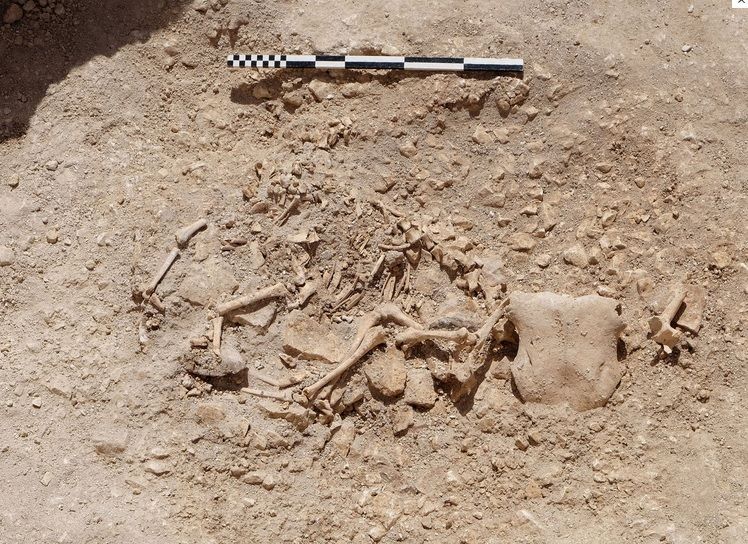Post by UKarchaeology on Jul 13, 2015 14:44:53 GMT

Ancient Mediterranean cultures thought nothing of splicing different animals together to form fantastical mythical beasts, such as the half-lion, half-goat chimera or the half-lion, half-eagle griffin.
Until now, however, ancient Britons were not credited with such imagination. That is all about to change following the discovery of a series of animal skeletons near Winterborne Kingston in Dorset, which raises the possibility that Britain’s ancient Celtic population had hybrid-animal monster myths similar to those of the ancient Greeks, Mesopotamians and Egyptians.
The bones, discovered in Dorset by archaeologists, appear to have been deliberately rearranged by Iron Age Britons in order to create hybrid beasts, half one creature and half another.
The Dorset ‘hybrids’ all discovered by archaeologists from Bournemouth University, include:
• A cow which, after probable sacrificial death, had had its own legs removed and deliberately replaced by four horse’s legs.
• A sacrificed sheep with two heads – its own somewhat fragmentary one and, protruding from its hind end, that of a bull.
• A horse with a cow’s horn protruding from its forehead – with the horn pointing inwards.
• A cow’s upper leg bone with a horse’s hoof
As well as these potential hybrid-style skeletal re-arrangement, the archaeologists – led by Bournemouth University prehistorians Miles Russell and Paul Cheetham – have discovered a series of ‘mix and match’ pairings of different animals and animal parts.
They have so far found two examples in which a jawless cow skull had been deliberately paired with a horse’s lower jaw. Another find was a complete dog with three cow lower jaws radiating from it.
One particularly bizarre arrangement of animal bones also involved a human skeleton. A young woman appears to have been sacrificed (there was an indication that her throat had probably been slit) – and was then buried on a ‘bed’ of specially arranged cattle, sheep, dog and horse bones. Significantly these animal bones had been deliberately sorted to mirror the bones of the dead woman. The animals’ skull fragments formed the surface her head rested on, while the animals’ leg bones formed the surface her legs rested on.
Archaeologists are now planning to analyse evidence from other sites in Britain and Western Europe and from Celtic mythology to try to understand what all the discoveries at the Dorset site might reveal about British Iron Age belief systems.
Other ritual burials of animals discovered at the site include five additional horse heads, 15 more cow heads, three complete pigs and three more complete dogs.
Most of the ‘hybrid-style’, ‘mix-and-match’ and other sacrificed animals at the site were found in disused storage pits under the entranceways to Iron Age houses on the site. It’s likely that all the sacrifices were made in the late first century BC when the settlement was being gradually abandoned. They appear to have been part of decommissioning rituals, probably carried out at the moment a house ceased to be lived in.
By excavating part of the site and by carrying out a geophysical survey (equivalent to ‘x-raying’ the ground), the archaeologists have concluded that the settlement consisted of 150-200 houses and that it flourished from around 100 BC to approximately 10 BC . The inhabitants were probably members of an early version of ancient Dorset’s Durotriges tribe.
As well as the sacrificed animals and the settlements’ many round houses, the archaeologists have also discovered evidence of Iron Age industrial activity – metal working (including iron, lead and copper smelting), pottery making and textile manufacturing.
“The discoveries are helping to transform our understanding of key aspects of Late Iron Age Britain – the type of society that existed just a couple of generations before the Roman conquest,” said Dr. Miles Russell, the Bournemouth University archaeologist who has been co-directing the excavation.
“Our investigations at the site suggest that life there was peaceful and prosperous. Although the settlement was relatively large, there appears to have been no defensive palisade or ramparts.
“The sacrifice of so many animals and the unusual treatment of their bones is likely to shed totally new light on Iron Age belief systems – and may suggest that the Ancient Britons had beliefs or mythologies which involved hybredized animals, just as the ancient Greeks had”.
The public will get a rare chance to see the excavation this Sunday 12 July, when the 32,000 sq m archaeological site, at North West Farm near Winterborne Kingston, Dorset – is opened from 10 am to 4pm.
(More pics: www.independent.co.uk/news/science/archaeology/news/the-boneyard-of-the-bizarre-that-rewrites-our-celtic-past-to-include-hybridanimal-monster-myths-10381965.html )
